28 de December de 2023
What Is An Explosive Strength Training Program Like?
What is Explosive Strength?
Strength can manifest itself in static/isometric, dynamic/active, and reactive forms, although it does not occur purely as one of these, but rather simultaneously to generate movement, transmit it from one part of the body to another, and absorb impacts (Tous Fajardo, 1999). In the following figure created by Joaquín Vico and published in Mundo Entrenamiento, the different manifestations of strength can be seen graphically. Within each manifestation of strength, there are subdivisions, among which explosive strength can be found, as shown in the figure, encompassing both dynamic/active and reactive strength.
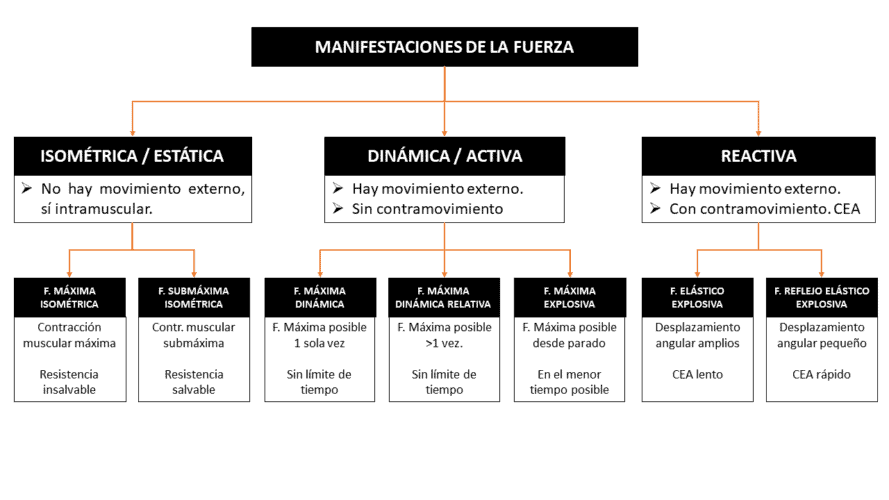
Explosive strength is the ability to exert force in the shortest possible time. This force can be applied from a standstill or after a counter movement. If performed from a standstill, without a previous counter movement, it falls under the dynamic or active manifestation of strength, which occurs in typical gym lifts (Günter & Tidow, 2006). Conversely, if explosive strength is executed with a preceding counter movement known as the stretch-shortening cycle (SSC), the manifestation of strength will be reactive, and we speak of elastic-explosive strength or elastic-reflex explosive strength (Palao et al., 2001).
To simplify, “plain” explosive strength is demonstrated in weightlifting lifts or explosive weightlifting exercises, while elastic-explosive strength is demonstrated in plyometric exercises. There are many nuances and further differences, but broadly speaking, this distinction helps us better understand how to design explosive strength training to be more explosive. It’s crucial to note that explosive strength is defined as applying maximum force in the shortest possible time.
At no point does its definition specify that loads must be low and speeds high. We emphasize this aspect because often we overlook this detail when designing explosive strength training and focus solely on exercises performed at high speeds, neglecting heavier lifts. However, if the athlete moves heavy weights at maximum speed, it could still be considered explosive strength (Pereira et al., 2015).
How to be More Explosive?
A program of explosive strength training combines speed, strength, and power exercises where we accelerate a load as fast as possible or perform a stretch-shortening cycle in the shortest time possible (Balshaw et al., 2022). Often, explosive strength training is limited to producing maximum power with high speeds and moderate loads. However, this is a specific training zone of the force-velocity curve, but we cannot forget about the other parts of this curve. In the following figure, you can see the three training zones mentioned: maximum velocity (red), force-velocity (black), and maximum load (green) (Haff & Nimphius, 2012).
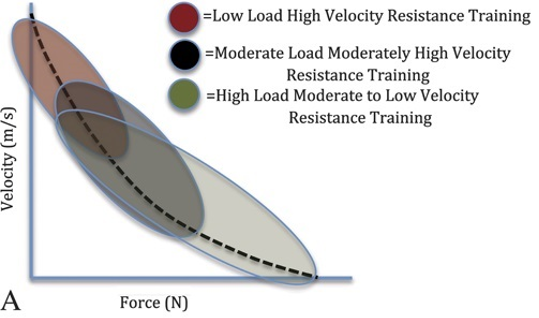
If we aim to become more explosive, our objective is essentially to apply the same force in less time, apply more force in the same time, or a combination of both: applying more force in less time. To achieve this, we must identify the specific needs of our sport and focus on them, but without neglecting the entire force-velocity curve.
In the following figure, heavy strength exercises are shown to improve the low-speed strength part of the curve (B), as seen in powerlifters. In image C) of the figure, we observe that explosive weightlifting exercises and ballistic movements enhance the force-velocity curve on the force side. Curve D), which is of interest, shows that this curve shifts to the right, gaining strength and speed, with resistance training that mixes exercises with different loads and at different speeds. This is how an explosive strength training program should be designed if we seek to become more explosive.
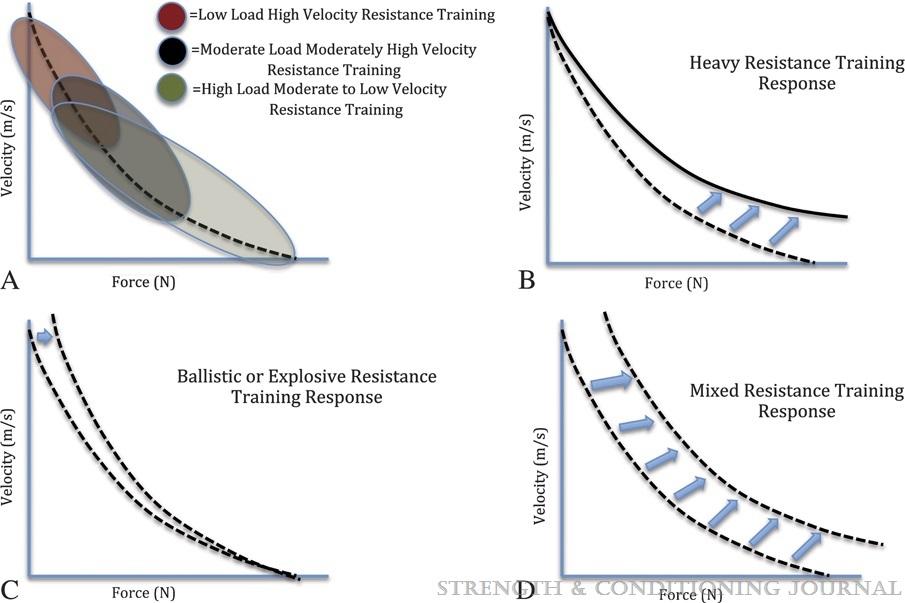
Figure extracted from (Haff & Nimphius, 2012)
The periodization of training involves setting seasonal goals and prescribing training so that each session builds on the previous one. In this blog article, we detail the fundamentals of periodization to understand the types of periodization that exist and why it is important. Scientific evidence has shown that a properly planned training program will produce significant improvements compared to one that does not follow periodization (Fisher & Csapo, 2021). A common mistake often seen is when coaches base their entire program on exercises aimed at speed with low loads and specificity of the sporting gesture, neglecting exercises with high loads and lower speeds.
Scientific literature recommends introducing training with higher loads and lower speeds, often referred to as “strength training,” to establish a foundation for later work on “explosive strength” with explosive weightlifting exercises (Behm et al., 2017). In summary, if you are seeking to become more explosive, exercises like sled sprints will help you achieve greater acceleration in running, but you will enhance gains even more by also performing heavy hip thrusts and explosive weightlifting exercises such as Olympic lifts (Alcaraz et al., 2018; Borges et al., 2016).
Therefore, explosive weightlifting exercises will have a significant place in an explosive strength training program, but we must not forget the entire force-velocity curve to maximize those gains. At the beginning of the article, we detailed that explosive strength is the manifestation of strength in which we lift a load in the shortest time possible, and we emphasize that lifting heavy loads at maximum speed could also be considered as “explosive strength.” Thus, general and heavy lifts such as squats, hip thrusts, deadlifts, bench press, military press, and rows with heavy loads will also be part of the periodization of an explosive strength program.
Everything is Explosive Strength: Just Place it on the Force-Velocity Curve
If we return once again to the force-velocity curve, we can place the different types of exercises that we have mentioned throughout the article. In the red zone, we find exercises with low load and high velocity, such as jumps, sprints, low-load plyometrics, punches, and throws with low load. As we slightly increase the load and decrease the velocity, between the red and black zones, we find plyometric exercises with a bit more load, such as weighted squat jumps, medicine ball throws, and Olympic lifts with low loads (30% – 40% of 1RM).

In the black zone, moderate to high loads are lifted at high speed. The kings of this zone are Olympic lifts and exercises performed with maximum power. The peak power is reached with a wide range of loads (30% – 80% of 1RM). To find the load at which we develop maximum power, we will use a velocity measurement device like Vitruve, which will tell us the power we apply in each repetition.
The green zone is intended for exercises with high loads (> 80% of 1RM) performed at low speeds. The goal in these movements should be to move the load as quickly as possible, but due to the heavy weight, the speed may appear slow from the outside, even if the athlete is pushing at maximum intentional speed. Heavy basic exercises such as back squats or bench press, among many others, fit into this zone of the curve.
Next, let’s look at the different explosive weightlifting exercises that fit into each zone of the force-velocity curve with which to design our explosive strength program. We won’t discuss exercises in the green zone (high loads and low speeds) not because they aren’t important, but because they are the classic exercises we all know where we’ll put a load above 80% and move the load at the maximum intentional speed possible. These exercises will be the foundation upon which we will later develop power. If you’re wondering how to become more explosive with these heavy exercises, first you must gain strength and then be able to apply it in the shortest possible time. That’s how an effective explosive strength training program works.
Olympic Lifts: The Kings of Explosive Weightlifting Exercises
The most well-known explosive weightlifting exercises are the Olympic lifts. From the snatch and the clean & jerk, many variations emerge that we can use depending on our goals. In the following figure, there are 10 explosive weightlifting exercises organized on the force-velocity curve. Remember that exercises performed at higher speeds are located in the upper left corner, while movements performed with heavier loads are located in the lower right corner. This continuum will always depend on the load used since the same exercise can shift more towards the speed side if performed with less load or towards the strength side if performed with more load.
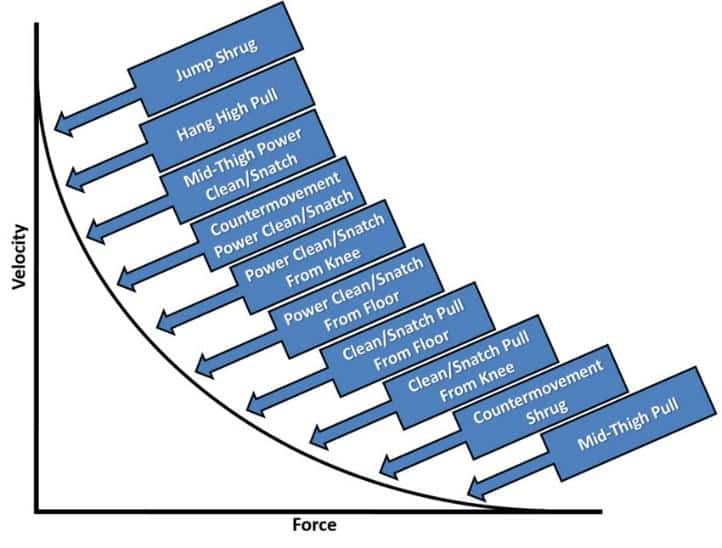
Imagen extraída de (Suchomel et al., 2017)
One of the variations of explosive weightlifting exercises located at the speed end is the jump shrug. If we add a bit more weight and remove the jump, we have the hang high pull. We continue to lose speed and gain weight with the mid-thigh power clean and the countermovement power snatch. These variations can be used with the clean or snatch according to our planning.
We now enter the middle zone of the force-velocity curve with the classic power variations of the snatch and the clean: from the knee (power clean/snatch from knee) or from the floor (power clean/snatch from floor). If we aim to add more weight, which will mean less speed, we will perform a full clean or snatch, as the previous ones were power variations and did not include the deep squat. Again, we can do the variation from the floor (clean/snatch pull from floor) or from the knee (clean/snatch pull from knee).
The last two variations, among the many we can do, are aimed at moving more weight than the rest we have seen. The countermovement shrug exercise and the mid-thig pull movement allow for more weight to be added, but the speed at which we move the bar will be lower. If we are looking to become more explosive, these explosive weightlifting exercises should be included in our explosive strength program.
Plyometrics and Ballistic Exercises: Jumps and Throws to Become More Explosive
Another group of explosive weightlifting exercises, including those using bodyweight, are those encompassed in plyometrics and ballistic movements. At the beginning of the article, we discussed the dynamic manifestation of strength, which starts from a standstill, and the reactive manifestation, which includes the stretch-shortening cycle (SSC). The training method for those seeking to become more explosive in the reactive explosive strength manifestation is plyometrics.
Through plyometrics, throws, and Olympic lifts discussed in the previous section, we will increase the rate of force development (RFD), which is simply applying force in less time. In the following figure, we can see how the increase in RFD would occur in the middle zone of the curve with these exercises, although the most affected zone will depend on the weight used in each exercise, as well as the exercise itself.
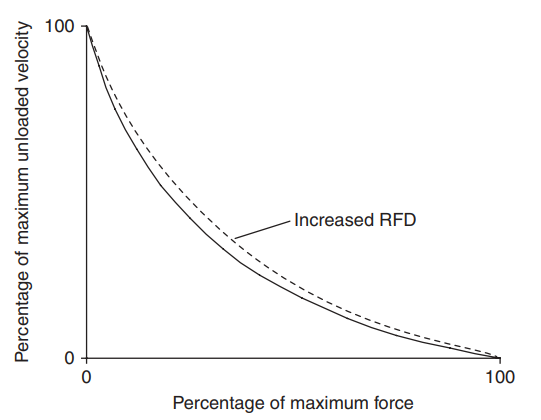
How to Incorporate Plyometric Exercises into an Explosive Strength Program
Plyometrics involves a rapid stretch-shortening cycle of our muscles and soft tissues, with classic examples being jump rope exercises. There are countless plyometric exercises for both the upper and lower body, with plyometrics predominantly used for the lower body. When designing plyometric exercises to become more explosive, it’s important to consider the following terminology:
- Jump: Takeoff with both legs and landing with both legs
- Hop: Takeoff with one leg and landing on the same foot
- Bound: Takeoff with one leg and landing with the opposite foot
- Skip: Takeoff with one leg and landing with both legs
In addition, plyometrics have different intensities, and it’s essential to start with exercises without plyometrics to learn how to land and decelerate before performing plyometric jumps, especially before jumping from a raised object. The sequence to follow if you’re looking to become more explosive with plyometric exercises is as follows: First, perform jumps without plyometrics to learn how to land, alternating between jump, hop, bound, and skip:
- Jumps onto a raised object (minimize eccentric tension): box jump, hop to box, lateral hop to box, lateral bound to box.
- Jumps over an object with landing without plyometrics: hurdle jumps and stick, single-leg hurdle hop and stick, single-leg lateral hurdle hop and stick jumps from a raised object with landing without plyometrics.
Once landing has been mastered and jumping and landing techniques have been learned, we will introduce true plyometrics. Here we add another jump after landing, either a single jump or in a sequence of them. Some of the many exercises we can do with an additional small bounce are:
- hurdle jumps with a bounce
- single-leg hurdle hops with a bounce
- single-leg lateral hurdle hops with a bounce
- 45-degree bound with a bounce
Another form of plyometrics is to perform explosive, controlled, and continuous movements like the following:
- continuous hurdle jumps
- continuous single-leg hurdle hops
- continuous single-leg lateral hurdle hops
- continuous 45-degree bounds
- power skips
All these exercises can be performed from an elevated surface, done diagonally, mixing jumps on two legs and one leg, etc. Plyometrics is an art in which the skill and knowledge of the coach will determine when, how, and why to perform each movement.
Medicine Ball Throws for Explosiveness
When training explosive strength in the upper body, we can classify four different types of medicine ball throws:
- Rotational pattern throws: Semi-kneeling rotational side throw, rotational front throw, and any throw involving trunk rotation.
- Overhead medicine ball throws in their various variations.
- Chest-pass medicine ball throws in their various variations.
- Ground slams (throws to the ground) in their various variations.
We should vary the complexity of the exercise and the weight of the medicine ball or load used to train in different parts of the force-velocity curve, although in this case, we are aiming for low load and high velocity.
Implemented Load and Exercises at Higher-Than-Natural Speed
If we move towards the end of the force-velocity curve, where speed is maximum and load is minimal, we can introduce exercises identical to those in the sport itself but with a slightly heavier load. Baseball pitchers use slightly heavier balls, batters do the same with bats, tennis players grip slightly heavier rackets, basketball or rugby players use heavier medicine balls for passing, etc. This method of training explosive strength aims to enhance our ability to apply greater RFD, meaning more force in less time, when using equipment specific to the sport.
Regarding sprinting and acceleration capacity, the key movement to develop explosive strength is sled dragging. The weight added to the sled depends on the desired objective and the zone of the force-velocity curve we want to train. A sled with lighter load allows the athlete to remain close to the natural sprinting motion they would perform without weight, while a heavier sled aims for the athlete to apply more tension with each stride, albeit at the expense of time. Uphill sprints are another similar method to sled dragging, helping to improve the athlete’s reactive explosive strength.
We can go even further and train at a higher speed than we could naturally develop. For this, there are assisted jumps with resistance bands or assistance in sprinting, such as downhill sprints, which allow us to develop more speed than our body would naturally permit without that assistance. These types of exercises are at the extreme, or even beyond it, of speed, as the force is minimal and the speed is supra-maximal.
Example of an Explosive Strength Training Program
A strength training program for explosive strength for the athlete seeking how to become more explosive should contain all the explosive weightlifting exercises we have seen in the article. The goal will be to periodize the training during different blocks throughout the season so that we focus more on some or others depending on our sport and the time of year we are in.
Below, we outline an 18-week training sequence to become more explosive, taken from Suchomel et al., (2017), which can give you an idea of what an explosive strength training program would look like. It is a general sample program, as it will be up to us as coaches and athletes to design our own program based on what has been discussed in this article.
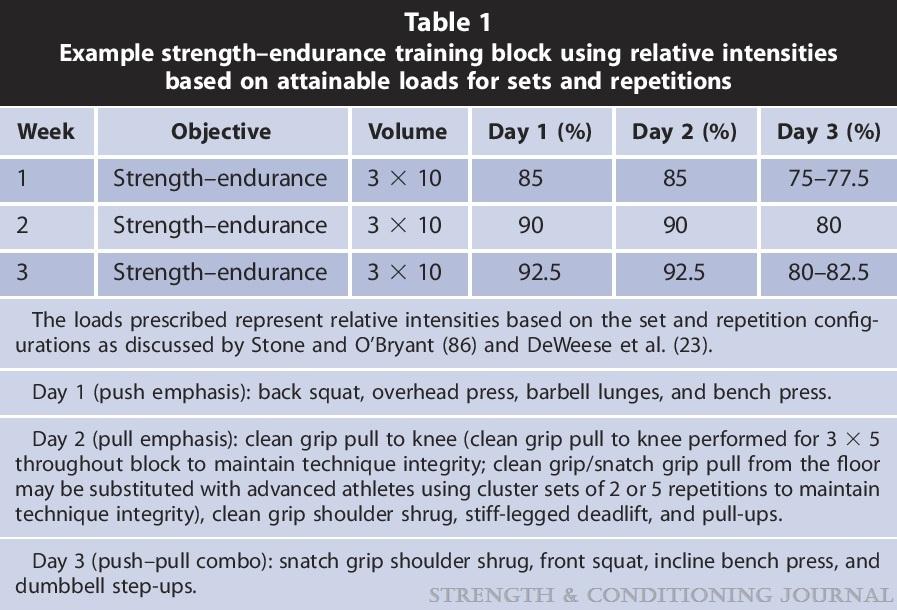
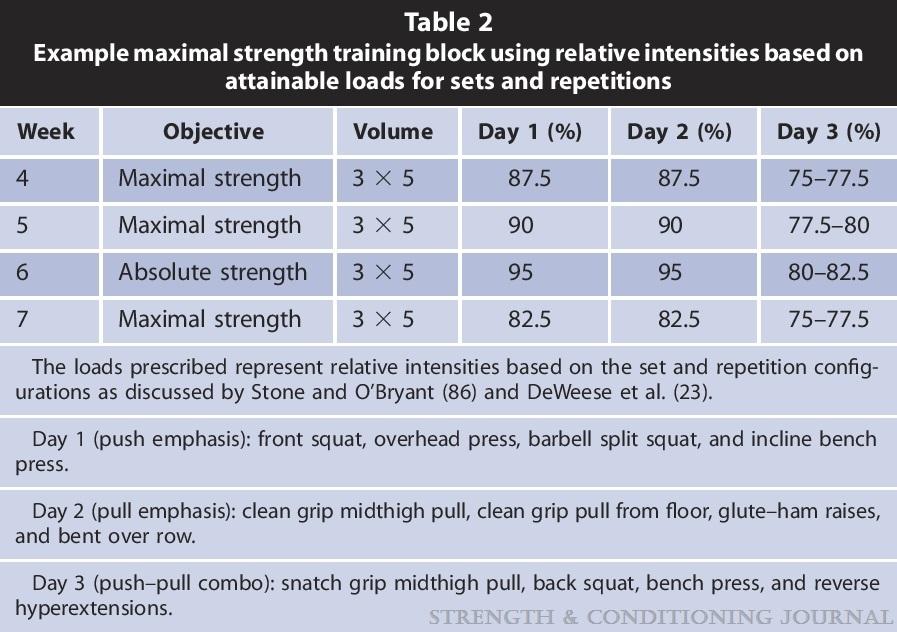
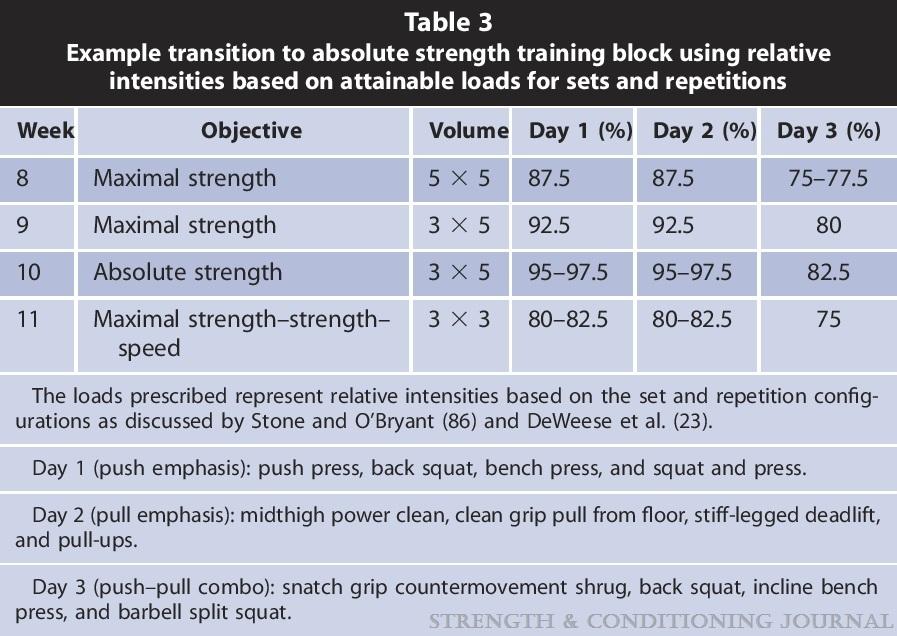
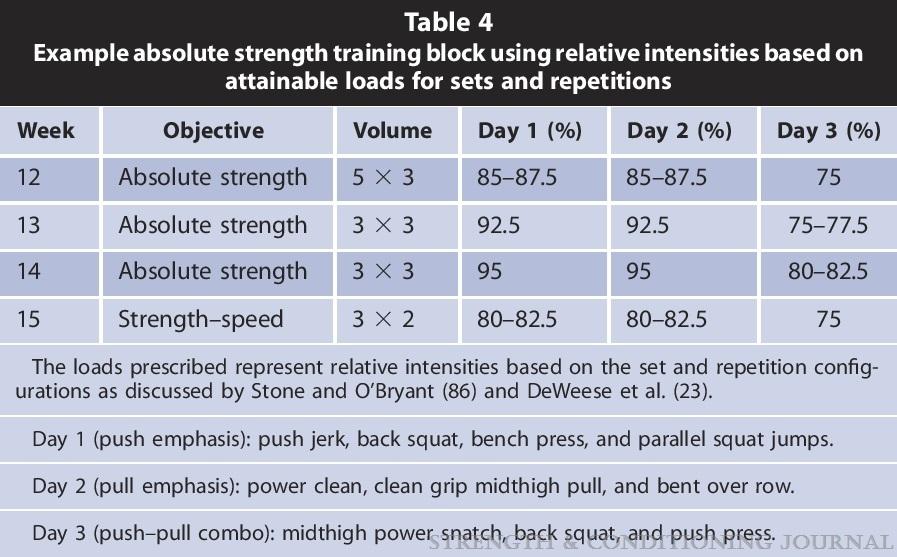
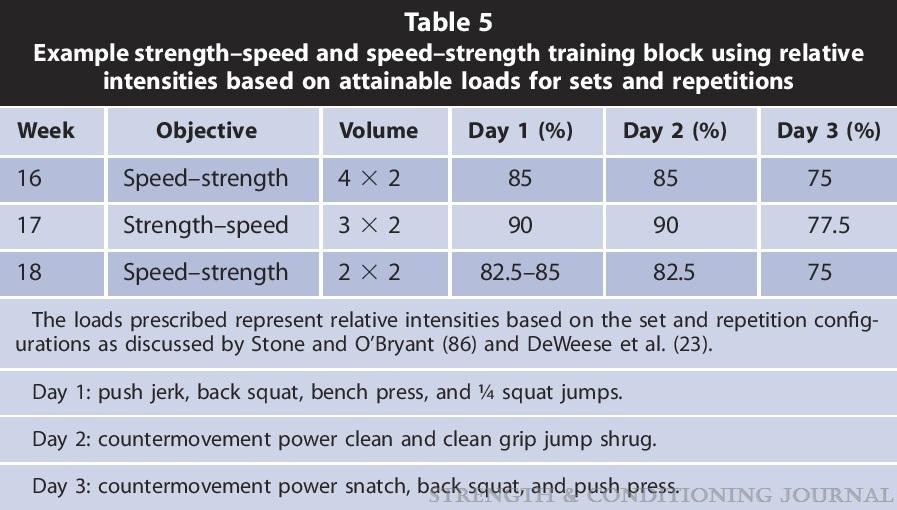
References
Alcaraz, P. E., Carlos-Vivas, J., Oponjuru, B. O., & Martínez-Rodríguez, A. (2018). The Effectiveness of Resisted Sled Training (RST) for Sprint Performance: A Systematic Review and Meta-analysis. Sports Medicine (Auckland, N.Z.), 48(9), 2143–2165. https://doi.org/10.1007/S40279-018-0947-8
Balshaw, T. G., Massey, G. J., Maden-Wilkinson, T. M., Lanza, M. B., & Folland, J. P. (2022). Effect of long-term maximum strength training on explosive strength, neural, and contractile properties. Scandinavian Journal of Medicine & Science in Sports, 32(4), 685–697. https://doi.org/10.1111/SMS.14120
Behm, D. G., Young, J. D., Whitten, J. H. D., Reid, J. C., Quigley, P. J., Low, J., Li, Y., Lima, C. D., Hodgson, D. D., Chaouachi, A., Prieske, O., & Granacher, U. (2017). Effectiveness of Traditional Strength vs. Power Training on Muscle Strength, Power and Speed with Youth: A Systematic Review and Meta-Analysis. Frontiers in Physiology, 8(JUN), 423. https://doi.org/10.3389/FPHYS.2017.00423
Borges, J. H., Conceição, M. S., Vechin, F. C., Pascoal, E. H. F., Silva, R. P., & Borin, J. P. (2016). The effects of resisted sprint vs. plyometric training on sprint performance and repeated sprint ability during the final weeks of the youth soccer season. Science & Sports, 31(4), e101–e105. https://doi.org/10.1016/J.SCISPO.2015.10.004
Fisher, J. P., & Csapo, R. (2021). Periodization and Programming in Sports. Sports (Basel, Switzerland), 9(2). https://doi.org/10.3390/SPORTS9020013
Günter, & Tidow. (2006). Aspects of strength training in athletics.
Haff, G. G., & Nimphius, S. (2012). Training principles for power. Strength and Conditioning Journal, 34(6), 2–12. https://doi.org/10.1519/SSC.0B013E31826DB467
Palao, J. M., Saenz, B., & Ureña, A. (2001). Efecto de un trabajo de aprendizaje del ciclo estiramiento-acortamiento sobre la capacidad de salto en voleibol. 1(3), 163–176. https://repositorio.uam.es/handle/10486/3788
Pereira, A., Costa, A. M., Santos, P., Figueiredo, T., & João, P. V. (2015). Training strategy of explosive strength in young female volleyball players. Medicina (Kaunas, Lithuania), 51(2), 126–131. https://doi.org/10.1016/J.MEDICI.2015.03.004
Suchomel, T. J., Comfort, P., & Lake, J. P. (2017). Enhancing the force-velocity profile of athletes using weightlifting derivatives. Strength and Conditioning Journal, 39(1), 10–20. https://doi.org/10.1519/SSC.0000000000000275
Tillin, N. A., & Bishop, D. (2009). Factors modulating post-activation potentiation and its effect on performance of subsequent explosive activities. Sports Medicine, 39(2), 147–166. https://doi.org/10.2165/00007256-200939020-00004
Tous Fajardo, J. (1999). Nuevas tendencias en fuerza y musculación. Barcelona: Ergo, 80–84. https://dialnet.unirioja.es/servlet/libro?codigo=182859

